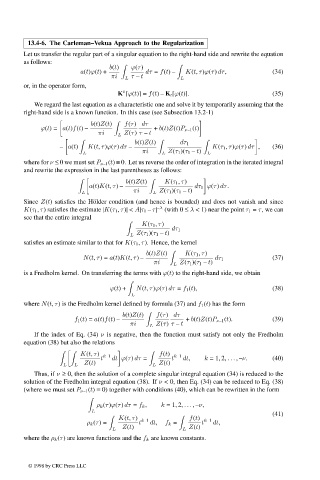Page 671 - Handbook Of Integral Equations
P. 671
13.4-6. The Carleman–Vekua Approach to the Regularization
Let us transfer the regular part of a singular equation to the right-hand side and rewrite the equation
as follows:
b(t) ϕ(τ)
a(t)ϕ(t)+ dτ = f(t) – K(t, τ)ϕ(τ) dτ, (34)
πi L τ – t L
or, in the operator form,
◦
K [ϕ(t)] = f(t) – K r [ϕ(t)]. (35)
We regard the last equation as a characteristic one and solve it by temporarily assuming that the
right-hand side is a known function. In this case (see Subsection 13.2-1)
b(t)Z(t) f(τ) dτ
ϕ(t)= a(t)f(t) – + b(t)Z(t)P ν–1 (t)
πi L Z(τ) τ – t
b(t)Z(t) dτ 1
– a(t) K(t, τ)ϕ(τ) dτ – K(τ 1 , τ)ϕ(τ) dτ , (36)
L πi L Z(τ 1 )(τ 1 – t) L
where for ν ≤ 0 we must set P ν–1 (t) ≡ 0. Let us reverse the order of integration in the iterated integral
and rewrite the expression in the last parentheses as follows:
b(t)Z(t) K(τ 1 , τ)
a(t)K(t, τ) – dτ 1 ϕ(τ) dτ.
L πi L Z(τ 1 )(τ 1 – t)
Since Z(t) satisfies the H¨ older condition (and hence is bounded) and does not vanish and since
K(τ 1 , τ) satisfies the estimate |K(τ 1 , τ)| < A|τ 1 – τ| –λ (with 0 ≤ λ < 1) near the point τ 1 = τ, we can
see that the entire integral
K(τ 1 , τ)
dτ 1
Z(τ 1 )(τ 1 – t)
L
satisfies an estimate similar to that for K(τ 1 , τ). Hence, the kernel
b(t)Z(t) K(τ 1 , τ)
N(t, τ)= a(t)K(t, τ) – dτ 1 (37)
πi L Z(τ 1 )(τ 1 – t)
is a Fredholm kernel. On transferring the terms with ϕ(t) to the right-hand side, we obtain
ϕ(t)+ N(t, τ)ϕ(τ) dτ = f 1 (t), (38)
L
where N(t, τ) is the Fredholm kernel defined by formula (37) and f 1 (t) has the form
b(t)Z(t) f(τ) dτ
f 1 (t)= a(t)f(t) – + b(t)Z(t)P ν–1 (t). (39)
πi L Z(τ) τ – t
If the index of Eq. (34) ν is negative, then the function must satisfy not only the Fredholm
equation (38) but also the relations
K(t, τ) k–1 f(t) k–1
t dt ϕ(τ) dτ = t dt, k =1, 2, ... , –ν. (40)
Z(t) Z(t)
L L L
Thus, if ν ≥ 0, then the solution of a complete singular integral equation (34) is reduced to the
solution of the Fredholm integral equation (38). If ν < 0, then Eq. (34) can be reduced to Eq. (38)
(where we must set P ν–1 (t) ≡ 0) together with conditions (40), which can be rewritten in the form
ρ k (τ)ϕ(τ) dτ = f k , k =1, 2, ... , –ν,
L
(41)
K(t, τ) k–1 f(t) k–1
ρ k (τ)= t dt, f k = t dt,
L Z(t) L Z(t)
where the ρ k (τ) are known functions and the f k are known constants.
© 1998 by CRC Press LLC
© 1998 by CRC Press LLC
Page 654

